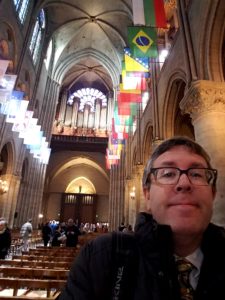I’m Listening to Everything Composed by Erik Satie (Part TWO)
April 5, 2019
(1866-1925)
A few years ago I researched the life and works of Erik Satie. Thus began my fascination with this strange, delightful, quirky, happy, odd man. In my earlier post on Satie, I focused on his most famous work “Gymnopedie #1.” This time I thought I’d focus on one of his earliest works, a set of character pieces—Ogives.
TITLE: Ogives
DESCRIPTION OF THE PIECE: This is a set of character pieces, or in other words, a set of relatively short pieces for solo piano. What is an ogive? (pronounced oh-jive, or in French, oh-zheev). Depending on what dictionary you refer to, it means either something mathematical (cumulative frequency graph), but the meaning I think is most likely the one Satie intended is an architectural term. This is an ogive:
 I feel quite confident in my assumption because Satie was highly religious and loved the architecture of Notre Dame cathedral. Here are some ogives in Notre Dame (on the ceiling…the criss-crossing arches):
I feel quite confident in my assumption because Satie was highly religious and loved the architecture of Notre Dame cathedral. Here are some ogives in Notre Dame (on the ceiling…the criss-crossing arches):
In addition, Satie was fascinated with medieval plainchant at this time in his life.
Here’s a brief example of the type of plainchant I am referring to:
Now listen to his Ogive #1 and I think you will be able to envision the architecture as well as hear the influence of medieval plainchant. It begins with a slow unison (in octaves) melody very reminiscent of plainchant. Then it bursts into large grand chords based on the simple opening melody. I believe this chordal version of the opening melody is intended to represent the architecture.
Ogive #1
It’s beautiful in its simplicity, no?
As you watched that video, perhaps you also noticed that he did not use any barlines at all, and there was no meter indicated. These choices appear to be another link to medieval plainchant; plainchant also does not use meter or barlines.
He wrote four of these and they all share the same characteristics. They start with a simple melody in octaves (reminiscent of plainchant) and then he repeats that phrase with a rich harmony in both hands and a loud volume, then it repeats again in a different harmonization at a soft volume and then the loud one repeats again. Same phrase four times. If you found that intriguing, you should listen to the others in the set:
Ogive #2
Ogive #3
Ogive #4 (dedicated to his younger brother, Conrad)
What INFLUENCE did these pieces have on music? Well, Debussy and Ravel heard Satie’s early works performed in various trendy clubs, including the Ogives and the Gymnopedies, and many believe that this led Debussy and Ravel directly into the style of composition for which they are known—Impressionism. Here’s a piece of impressionist music by Debussy—La Cathedrale Engloutie (The Sunken Cathedral). As you listen, pay attention to see if you can hear the influence of Satie’s Ogives. Even if you only listen to the first 30 seconds, I think you’ll notice it.
If THAT’s not related in some way to the Ogives, I don’t know what is. I mean, it even has cathedral in the title.
Perhaps I’m going too far with this, but…yeah, I’m just going to say it:
If not for Satie, we wouldn’t have Impressionist music…AMAZING!
HIGHLIGHT: For me, the highlight is the sacred simplicity of this work. The minimalist repetitions…Hey, maybe we wouldn’t have minimalism without Satie!
WHAT’S LEFT TO LISTEN TO BY SATIE?: A bunch but I can do it.
